Fast Facts

United States
- Despite the impact of COVID-19, the FTC and DOJ concluded 70 percent more significant investigations in the first half (H1) of 2020 than in H1 2019.
- DAMITT industry data show that the U.S. agencies continue to devote much of their resources to the healthcare and pharmaceuticals sector, which has accounted for about one-third of the significant investigations since 2011 and in H1 2020. The agencies concluded no significant investigations in the technology sector in H1 2020, even though the sector accounted for more than 30 percent of H1 2019 activity.
- Even with the increased volume, the U.S. agencies completed significant investigations in H1 2020 about two months faster than in H1 2019.
- The FTC shortened its significant investigations during H1 2020 to an average of 10.5 months, shaving more than five months from its average during H1 2019. DOJ investigations averaged 9.8 months over H1 2020, roughly even with its average during H1 2019.
- For the fourth consecutive quarter, no significant investigations involved vertical issues, despite the agencies’ recent release of the Vertical Merger Guidelines.
European Union
- To date, the pandemic has had no significant impact on merger review in the EU; despite the Commission working remotely and asking parties to delay notifications, the number of notifications and issued decisions were both in line with the previous year.
- The number of significant EU investigations decreased, however, continuing the trend observed in 2019; the EU Commission concluded 34 percent fewer significant investigations during the 12 months ended Q2 2020 than in the 12 months ended Q2 2019.
- Similar to the U.S., the healthcare and pharmaceuticals sector has kept the EU Commission busiest, accounting for one-third of EU significant investigations resolved in H1 2020. The Commission did not conclude any significant investigation in the technology sector in the past 18 months, but there are significant investigations in the pipeline.
- The average duration of EU Phase II investigations resolved in the 12 months ended Q2 2020 rose by 16 percent from the prior 12-month period. At the same time, however, the average duration of significant Phase I investigations, at 8.2 months, remained in line with the previous 12-month period.
- Two transactions, Boeing/Embraer and Johnson & Johnson/TachoSil, were abandoned in Phase II, tying the annual record over the 2011-2020 period tracked by DAMITT.
The Dechert Antitrust Merger Investigation Timing Tracker (DAMITT) is a quarterly release from Dechert LLP reporting on trends in significant merger control investigations in the United States (U.S.) and European Union (EU).
In the U.S., “significant” merger investigations include Hart-Scott-Rodino (HSR) Act reportable transactions for which the result of the investigation by the Federal Trade Commission (FTC) or the Antitrust Division of the Department of Justice (DOJ) is a consent order, a complaint challenging the transaction, an official closing statement by the reviewing antitrust agency or the abandonment of the transaction with the antitrust agency issuing a press release.
In light of the procedural differences between the EU and U.S., DAMITT defines “significant” EU merger investigations to include transactions subject to the EU Merger Regulation and resulting in either Phase I remedies or the initiation of a Phase II investigation.
DAMITT calculates the durations of significant investigations in both jurisdictions from the date of deal announcement to the completion of the investigation, which therefore includes the time attributable to pre-notification consultation efforts.
The U.S. Agencies Completed a Record Number of Significant Investigations in H1 2020 Despite the Pandemic
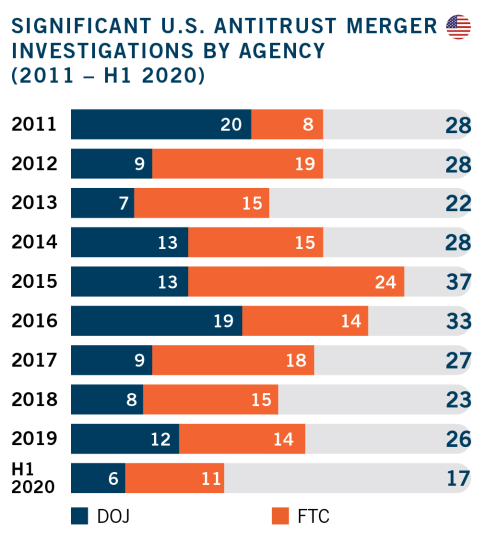
The U.S. antitrust agencies have acted at a record-setting pace in 2020 despite the COVID-19 pandemic, completing 17 significant merger investigations in H1 2020 — the highest total for the first half of any year spanning DAMITT’s decade of data. This represents a 70 percent increase over the 10 significant merger investigations completed in H1 2019. Similarly, the 33 significant merger investigations completed over the 12 months ended Q2 2020 is a 65 percent increase over the 20 significant merger investigations concluded over the 12 months ended Q2 2019. The FTC recently noted that 2020 may be “one of the busiest years for merger enforcement in 20 years.” However, the pace may slow in the back half of the year due to a decline in pre-merger filings during the pandemic.
Three significant merger investigations in H1 2020 (Edgewell/Harry’s, Peabody Energy/Arch Coal and Jefferson Health/Albert Einstein Healthcare Network) resulted in FTC complaints seeking to block transactions, compared to only one such complaint in H1 2019. Only once in the past decade (H1 2018) did the agencies file three litigation complaints in the first half of the year.
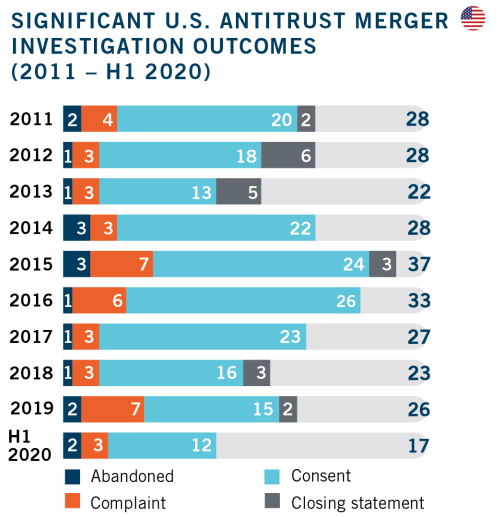
Two significant investigations in H1 2020 concluded with the agencies taking credit for the parties’ decision to abandon their transactions. H1 2019 also saw two significant investigations ending the same way.
For the fourth consecutive quarter, no vertical issues were raised in any significant U.S. investigations. In comparison, vertical issues were publicly identified in 30 percent of significant merger investigations concluded in H1 2019 and 25 percent of the investigations concluded over the 12 months ended Q2 2019. This recent trend is noteworthy in light of the agencies’ recent public statements regarding vertical mergers, including their newly issued Vertical Merger Guidelines. Of course, the decline could also indicate that fewer proposed mergers have raised significant vertical issues, and not that the agencies have retreated from their announced enforcement policies concerning vertical mergers.
Number of Significant EU Investigations Matches Lower 2019 Levels
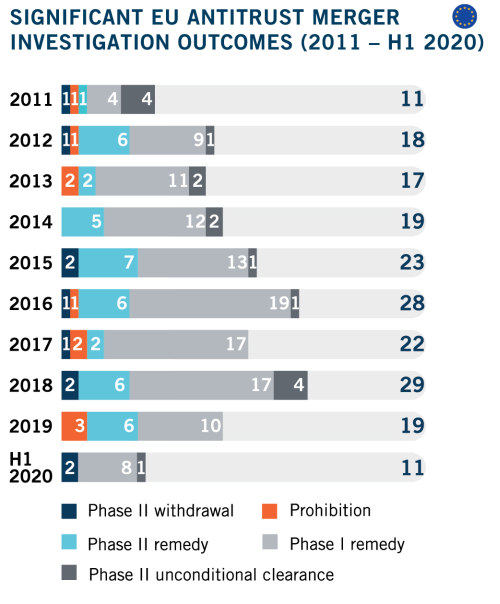
Despite the pandemic, the EU Commission has been as busy thus far in 2020 as it was in 2019, looking at all merger decisions issued; but the number of significant EU investigations remains low by the standards of previous years. The EU Commission concluded six significant EU merger investigations in Q2 2020, bringing the total number for H1 2020 to 11. This is in line with H1 2019 and on pace to match the number of significant investigations observed in 2019. As observed in the DAMITT 2019 annual report, however, that year saw the lowest number of significant investigations over the past five calendar years. The pattern of fewer significant investigations in 2019 and continuing in H1 2020 does not appear to be due to any slackening of enforcement intent; instead, it may be a reversion to the mean after a few years of exceptionally high levels of significant investigations.
Three of the six significant EU merger investigations resolved in Q2 2020 were cleared with remedies, all in Phase I. Two Phase II investigations were terminated following the parties’ withdrawal of their notification (Boeing/Embraer and Johnson & Johnson/TachoSil). The remaining Phase II case was cleared unconditionally. This H1 2020 total already matches the highest number of withdrawals in any year during the 2011-2019 period tracked by DAMITT. At the time of publication, the Commission had already issued one more Phase II decision and there are six ongoing Phase II investigations, including LSEG/Refinitiv Business and EssilorLuxottica/Grandvision. Absent any unexpected delays in some reviews, the number of Phase II cases resolved in 2020 should be in line with the average of eight Phase II decisions per year observed since 2011.
As explained in the DAMITT Q1 2020 report, early on in the pandemic the EU Commission, in line with a number of agencies worldwide, took steps to manage the flow of new cases. The EU Commission asked parties to postpone non-essential notifications, since it anticipated difficulties in collecting information from third parties for market-testing purposes, and in staff remotely accessing information and databases. There has not, though, been any sharp downward inflection in activity, with remote working arrangements for officials functioning effectively.
The number of all cases resolved by the EU Commission in H1 2020 corresponds to 48 percent of the number of decisions adopted in the entire FY 2019. Unlike the significant decline in the U.S., the total number of EU notifications in H1 2020 (169) was down by only about 10 percent compared to the same period in 2019. These reductions are no greater than variations observed from one year to another in the past. The limited impact may be a function of the fact that the large majority of cases reviewed by the EU Commission are short form/simplified cases (i.e., cases that do not require extensive market investigation). As such, they are less likely to have been postponed. Down the line, however, the delays triggered by the pandemic may have a stronger impact on the number of significant EU investigations, reinforcing the downward trend observed since 2019, as well as on their duration.
By way of comparison, there has been a steeper decline – of around 30 percent – in the number of transactions notified in Germany in H1 2020 compared to the same period in 2019. Because, unlike in the EU, parties are not required to engage in pre-notification discussions with the German Federal Cartel Office, the time lag between announcement and notification is limited and it is therefore possible that, later in the year, the EU may follow the trends observed in Germany and the U.S. with regard to the number of notifications.
U.S. Antitrust Agencies Accelerate Pace of Investigations
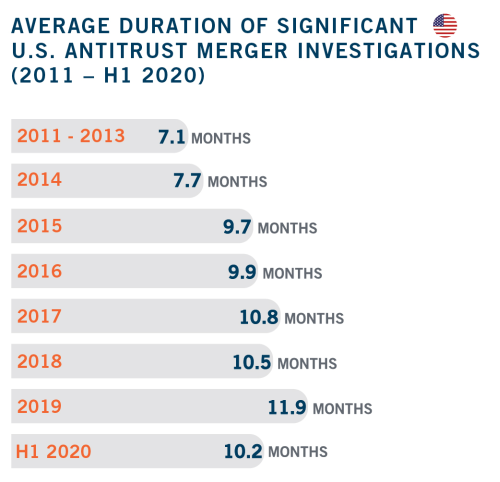
Despite teleworking requirements at both the DOJ and FTC, the agencies have picked up the pace of significant merger investigations completed this year. For H1 2020, the average duration from deal announcement to the end of the investigation was 10.2 months, down 16 percent from the 12.1-month average for H1 2019. During the 12 months ended Q2 2020, the average length of significant investigations was 10.9 months, about half a month faster than the 11.4-month average over the 12 months ended Q2 2019. These durations are trending lower from the 11.9-month peak in the DAMITT data for calendar year 2019.
In particular, an uptick in speed by the FTC drove the average significant investigation duration lower in the 12 months ended in Q2 2020. FTC investigations lasted 11.5 months on average during the 12 months ended in Q2 2020, compared to 13.5 months in the 12 months ended Q2 2019.
DOJ, meanwhile, held steady in terms of duration. DOJ significant investigations took an average of 9.9 months for the 12 months ended Q2 2020, roughly two weeks longer than the 9.4-month average for the same period ended Q2 2019. While FTC investigations took an average of four months longer than DOJ investigations in the 12 months ended Q2 2019, the FTC has narrowed the gap to 1.6 months for the 12 months ended Q2 2020.
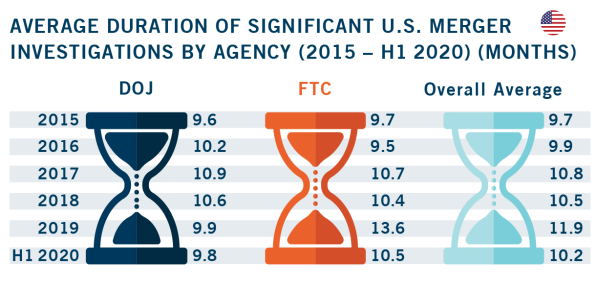
Spanning just under 18 months, the Jefferson Health/Albert Einstein Healthcare Network merger represented the longest significant U.S. merger investigation concluded in H1 2020. Although lengthy, that investigation was far shorter than the longest investigation of 2019, the 28-month look at the Quaker Chemical/Houghton merger.
The median duration for all U.S. significant investigations over the 12 months ended Q2 2020 was 9.8 months, consistent with the median from the equivalent period ending Q2 2019. The median significant investigation length for the FTC over the 12 months ended Q2 2020 was 10.5 months, compared to a median of 13.2 months for the 12 months ended Q2 2019.
This indicates that the typical FTC significant investigation is taking less time and that there are fewer deals at the top end of the spectrum pulling the average higher. Only 14 percent of significant FTC investigations took longer than 15 months in the 12-month period ended Q2 2020, while in the 12-month period ended Q2 2019, 50 percent of investigations took longer than 15 months. The median duration for DOJ in the 12 months ended Q2 2020 was 9.5 months, close to the DOJ’s 9.9-month average for the same period with relatively low variation in durations.
Prior DAMITT analyses found that antitrust merger litigation added an additional five to seven months to the merger process, as observed in the Evonik/PeroxyChem case which lasted 5.9 months from the complaint to the decision in Q1 2020. Recent and pending antitrust merger litigations suggest that this average may be trending upward. The only litigation concluded in Q2 2020, the Sabre/Farelogix transaction, reached a verdict on April 7, 2020, about 7.7 months after the complaint was filed.
With regard to pending merger litigation, the Peabody/Arch Coal preliminary injunction case began on July 14, 2020 and is expected to last 10 days. With the hearing set to start 4.6 months after the complaint was filed, the case is on track to land on the longer end of the five to seven month DAMITT litigation average. The preliminary injunction hearing in the Jefferson Health/Albert Einstein Healthcare Network case is scheduled to begin on September 14, 2020, 6.6 months after the complaint was filed, indicating that this litigation will likely exceed the DAMITT average. Other FTC complaints issued in the last six months resulted in the abandonment of the Edgewell/Harry’s, Illumina/PacBio, Cengage/McGraw-Hill, and Post Holdings/TreeHouse Foods mergers.
Duration of EU Phase I Remedy Cases Remains Stable; Duration of EU Phase II Cases Trends Upward
The average duration of Phase I remedy cases remains steady: investigations resolved in Phase I during the 12 months ended Q2 2020 averaged 8.2 months, only slightly down from the average duration of 8.5 months over the prior 12-month period.
The average duration of Phase II proceedings continues to trend upward: investigations concluded during the 12 months ended Q2 2020 averaged 15.5 months, up 16 percent from the 13.3-month average observed over the prior 12-month period.
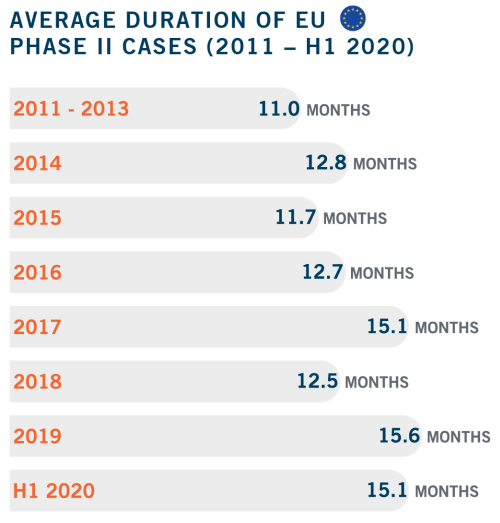
EU Phase II Proceedings
The average duration of Phase II investigations remained at the top end of average durations observed by DAMITT since 2011. The 15.1-month average duration for Phase II proceedings resolved in H1 2020 is just under the highest annual average of 15.6 months over the 2011-2019 period tracked by DAMITT.
This high figure is largely attributable to the Boeing/Embraer investigation which had already run for 22.4 months at the time it was abandoned, making it the third-longest investigation since 2011. In contrast, the investigations in Aurubis/Metallo Group and Johnson & Johnson/TachoSil lasted 11.6 and 11.2 months, respectively: this is well below the 2011-2019 average of 12.5 months. These two investigations are unusual — Johnson & Johnson/TachoSil was abandoned less than 15 days after the Commission opened an in-depth investigation and Aurubis/Metallo Group Holding was pulled-and-refiled, which remains a rare occurrence in EU merger control practice. Furthermore, it was the first time a pulled-and-refiled transaction proceeded to Phase II since DAMITT started tracking the data in 2011.
The average duration of pre-notification contacts (i.e., from announcement until notification) of Phase II transactions resolved during the 12 months ended Q2 2020 was 8.5 months, a significant increase from the 6.6-month average in the prior 12-month period. However, excluding the exceptional delay of 14 months in Boeing/Embraer, the H1 2020 average would decline to a more typical 7.2 months.
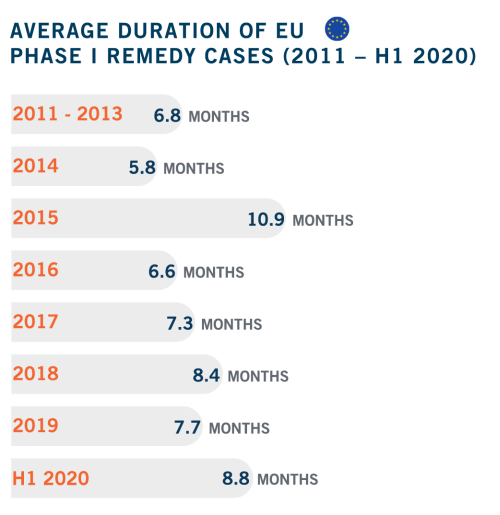
EU Phase I Remedy Cases
Although the average duration of Phase I remedy cases resolved in H1 2020 showed a one-month increase relative to 2019, the duration of reviews remained steady on a rolling 12-month basis. On average, Phase I remedy cases in H1 2020 lasted 8.8 months, up from the 2019 average of 7.7 months. The 8.2 month average duration of investigations concluded during the 12 months ended Q2 2020 remained in line with the 8.5-month average observed during the previous 12-month period. Phase I investigations resolved with remedies now tend to require more than five times the theoretical duration of the fixed timetable under the EU Merger Regulation.
The average duration of pre-notification contacts for Phase I remedy cases also remained relatively steady. The average of 6.5 months in the pre-notification period for Phase I remedy cases resolved during the 12 months ended in Q2 2020 is close to the 6.7-month average observed over the prior 12-month period.
Transactions in the Healthcare and Pharmaceuticals Sector Continue to Keep Both U.S. and EU Enforcers Busy
DAMITT analyzed trends involving the relative frequency and average duration of significant investigations by sector dating back to 2011.
This analysis revealed that the healthcare and pharmaceuticals sector continues to account for the highest number of significant investigations in the U.S. and the second highest number of significant investigations in the EU. In addition, both jurisdictions have observed a decline in significant investigations in the technology sector.
In the U.S., Healthcare and Pharmaceuticals Mergers Spike to Highest Percentage of Significant Investigations Since 2015, as Significant Technology Sector Investigations Plummet
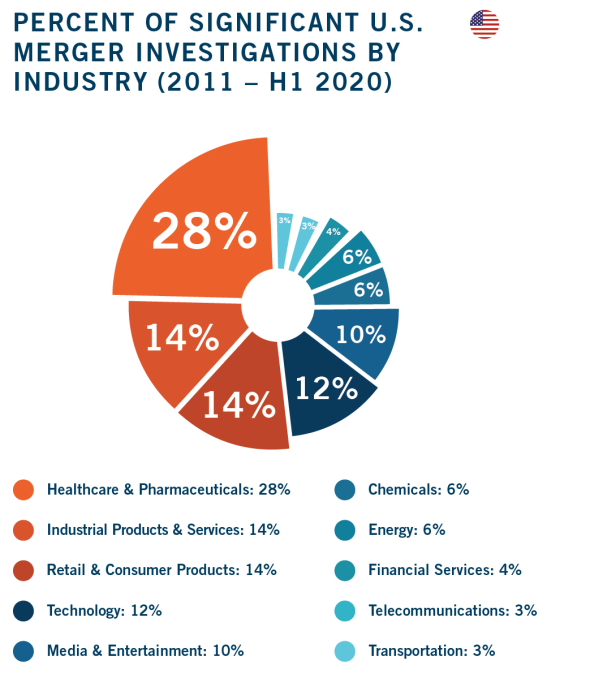
The healthcare and pharmaceuticals sector accounted for six of the 17 significant investigations (35 percent) completed in H1 2020. For the 12 months ended in Q2 2020, healthcare and pharmaceuticals investigations accounted for 27 percent of significant investigations. This sector has consistently accounted for roughly 28 percent of U.S. significant investigations since 2011.
The retail and consumer products sector and the industrial products and services sector currently tie for second at 14 percent of significant investigations since 2011, with each comprising 29 percent of significant investigations in H1 2020. For the 12 months ended in Q2 2020, retail and consumer products mergers accounted for 21 percent of significant investigations, and industrial products and services mergers constituted 24 percent.
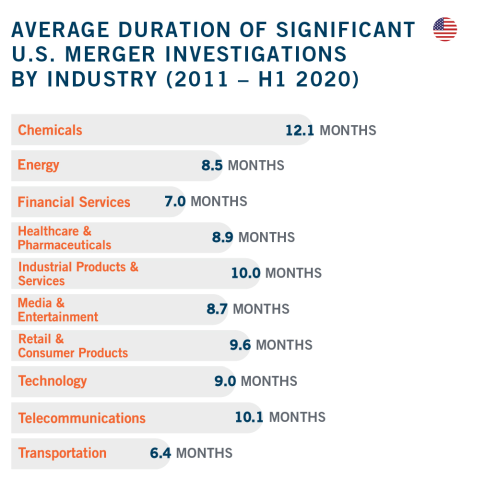
While the agencies saw an uptick in the percentage of significant investigations in the healthcare and pharmaceuticals sector in H1 2020, those in the technology sector fell off in H1 2020. No significant investigations in the technology sector concluded in H1 2020, compared to a total of 30 percent of significant merger investigations concluded in H1 2019. This is surprising in light of the establishment of the FTC Technology Enforcement Division. Of course, this trough could represent a lull before an increase in agency enforcement in this area, as the agencies devote additional resources to the technology space.
The average duration of significant U.S. investigations continues to show variation based on sector. Since 2011, chemical sector significant investigations have taken the longest at 12.1 months on average. By comparison, significant investigations in the financial services and transportation industries have taken only about half as long, averaging 7.0 and 6.4 months, respectively.
In the EU, DAMITT observes Sectoral Variations for Phase I and II Clearances; Uptick in the Proportion of EU Significant Investigations in the Healthcare & Pharmaceuticals Sector
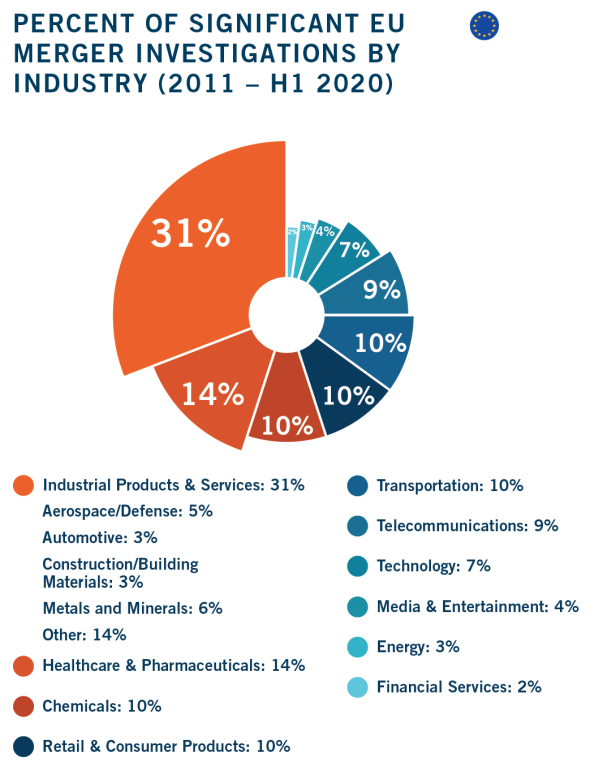
In the EU, healthcare and pharmaceuticals deals accounted for one-third of significant investigations concluded in the first half of 2020, with the aerospace/defense sector coming in second place. Similar to the U.S. experience, no significant EU investigation in the technology sector was resolved over the past 18 months. This does not however demonstrate a lack of either transaction activity or enforcement in this sector, and two transactions in the technology sector are already undergoing significant investigations at the time of writing (LSEG/Refinitiv Business and Google/Fitbit).
There has been a slight decrease in the proportion of significant transactions in the industrial products and services sector during the last 12 months, but at 31 percent it still accounts for the largest share over the 2011-H1 2020 period tracked by DAMITT. This sector includes transactions in a number of sub-sectors that have witnessed significant enforcement activity in the EU, such as metals and minerals and aerospace/defense. The proportion of EU significant investigations in the healthcare and pharmaceuticals sector stands at 14 percent, putting it in second place. The retail and consumer products, chemicals, and transport sectors are all tied for third place with each sector representing 10 percent of EU significant investigations.

The breakdown of the data between significant Phase I and Phase II investigations also reveals differences in the proportion of Phase II investigations across sectors. For instance, over the 2011-H1 2020 period tracked by DAMITT, 89 percent of significant EU merger investigations in the healthcare and pharmaceuticals sector were resolved in Phase I with remedies; whereas a Phase II investigation was opened in 72 percent of significant investigations in the telecommunications sector. The established decisional practice of the EU Commission in a number of sectors (e.g., healthcare and pharmaceuticals and transportation) is likely a facilitating factor allowing parties to identify potential issues and remedies early on.
A review of the average duration of significant EU Phase I and Phase II investigations by sector highlights substantial timing differences. The construction/building materials sector remains the sector with the longest average duration over the 2011-H1 2020 period tracked by DAMITT in both Phase I and Phase II cases at 10.4 and 18.1 months, respectively.
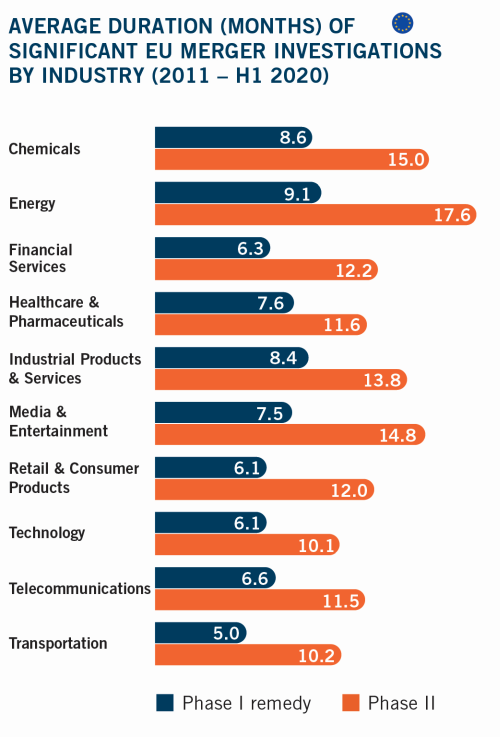
In contrast, transactions in the transportation sector account for the shortest average duration for significant Phase I investigations at only 5.0 months from announcement to clearance over the 2011-H1 2020 period tracked by DAMITT. The relative speed of significant investigations in this sector is further reflected in the average duration of Phase II proceedings: the 10.2-month average for deals in the transportation sector is slightly longer than the shortest average duration of 10.1 months for deals in the technology sector since 2011.
Phase II proceedings are on average roughly twice the length of Phase I reviews. But the analysis shows that the increase in duration between Phase I and Phase II varies across sectors. For instance, undergoing a Phase II review in the technology sector adds only 4.0 months on average to the review timetable; whereas transactions in the energy sector show the biggest jump with an average increase of 8.5 months.
Summary
While the circumstances of any individual transaction will naturally vary from the DAMITT averages depending on various factors (e.g., which agency conducts the review), current statistics suggest that parties to the hypothetical average significant investigation subject to review only in the U.S. would have to plan on approximately a year for the agencies to investigate a transaction. Parties should further allow an additional five to seven months if they want to preserve their right to litigate an adverse agency decision.
Deal timetables for EU cases where the investigation is likely to proceed to Phase II need to allow for a lapse of around 15 months from announcement to clearance. If the investigation is likely to be resolved in Phase I with remedies, the deal timetable should allow for approximately nine months from announcement to a decision.
DAMITT’s sector-based analysis demonstrates that the average duration of significant merger investigations varies by industry in both the U.S. and EU. In the U.S., the numbers show that significant investigations can take less than half as long on average in some industries (e.g., financial services, transportation) compared to others (e.g., chemicals). In the EU, the duration of significant investigations depends naturally on the likelihood of clearance in Phase I versus Phase II. The existence of clear guidance in the form of long-standing published decisional practice in certain sectors significantly improves the prospect of merger clearance in Phase I.





